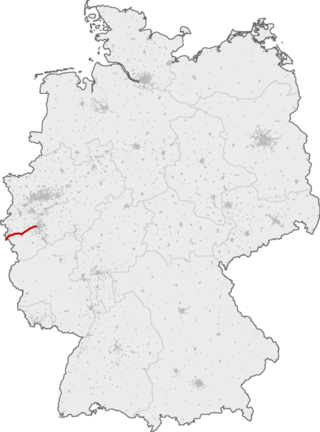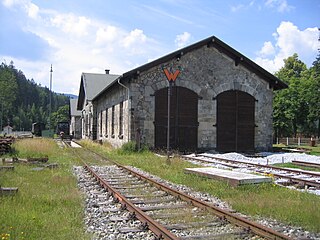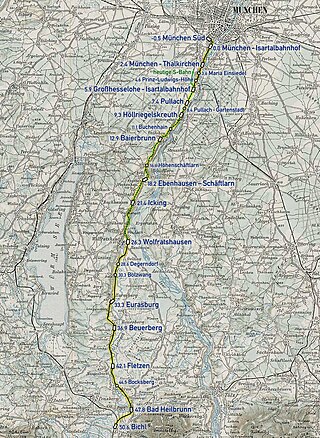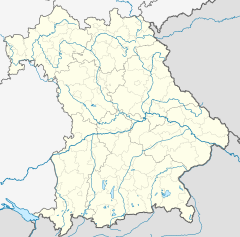
Holzkirchen is a market town in Bavaria, Germany. With a population of over 16,000 (2008) it is the largest town in the Miesbach district.

The Munich S-Bahn is an electric rail transit system in Munich, Germany. "S-Bahn" is the German abbreviation for Stadtschnellbahn, and the Munich S-Bahn exhibits characteristics of both rapid transit and commuter rail systems.

The Brig–Zermatt railway line is a metre gauge railway line in the canton of Valais in Switzerland. Its 44-kilometre (27 mi)-long line links the communities of Brig and Visp in the Rhone Valley with Täsch and the car free holiday resort of Zermatt in the Mattertal. The line also forms part of the much travelled and admired route of the Glacier Express between St. Moritz and Zermatt. The Gornergratbahn is connected with the line at Zermatt.

The Bayerische Oberlandbahn GmbH (BOB) is a private railway company based in Holzkirchen, Germany, and owned by Transdev Germany. Since June 2020 its services are operated under the brand Bayerische Regiobahn (BRB) of its sister company.

The Cologne–Aachen high-speed line is the German part of the Trans-European transport networks project high-speed line Paris–Brussels–Cologne. It is not a newly built railway line, but a project to upgrade the existing railway line which was opened in 1841 by the Rhenish Railway Company. When it was continued into Belgium in 1843, it became the world's first international railway line.

München Hauptbahnhof or Munich Central Station is the main railway station in the city of Munich, Germany. It is one of the three stations with long-distance services in Munich, the others being Munich East station and Munich-Pasing station (München-Pasing). München Hauptbahnhof sees about 450,000 passengers a day, which puts it on par with other large stations in Germany, such as Hamburg Hauptbahnhof and Frankfurt (Main) Hauptbahnhof. It is classified by Deutsche Bahn as a category 1 station, one of 21 in Germany and two in Munich, the other being München Ost. The mainline station is a terminal station with 32 platforms. The subterranean S-Bahn with 2 platforms and U-Bahn stations with 6 platforms are through stations.

Munich-Pasing is a railway station in the west of Munich. It is the third-largest station in the city, after München Hauptbahnhof and München Ost.

Munich-Trudering station is an interchange station of the Munich S-Bahn and the Munich U-Bahn in the borough of Trudering-Riem in the Bavarian capital of Munich.

The Bavarian Localbahn Society, with its headquarters in Tegernsee, is a society that is concerned with the history of the railways in Bavaria. Localbahn means 'branch line' and is mainly used in southern Germany and Austria in lieu of the usual term Nebenbahn. The BLV's objectives are the operation of historic trains and the collection of historically valuable railway items from Bavaria.

The Mangfall Valley Railway is a single-tracked, electrified railway that runs through the Mangfall valley in Bavaria, Germany, between Holzkirchen and Rosenheim. It is exclusively used by regional services. However it also acts as a diversionary line in case of difficulties on the Munich–Rosenheim railway.

The Brunswick–Uelzen railway line is a largely, single-tracked, non-electrified branch line in the north German state of Lower Saxony. It serves the northern part of Brunswick Land and the eastern region of the Lüneburg Heath. The most important station en route is Gifhorn. The line has also been called the Mühlenbahn for several years due to the many mills along its route.

The Munich–Rosenheim railway is a 65 kilometre-long double-track main line of the German railways. It connects Munich Hauptbahnhof with Rosenheim station, where it connects with the Rosenheim–Salzburg railway, which connects with the line to Vienna at Salzburg, and the line to Kufstein, which continues to Innsbruck and the Brenner line to Italy. The line is part of the "Main line for Europe", connecting Paris with Bratislava and Budapest and the almost identical line 17 of Trans-European Transport Networks (TEN-T). It is part of the line 1 of TEN-T. It is electrified at 15 kV, 16.7 Hz. It was opened between Munich and Rosenheim in 1871.

Grafing station is a station in the Bavarian town of Grafing and a station of the Munich S-Bahn. There is also the S-Bahn station of Grafing Stadt in central Grafing. The station has six platform tracks and is classified by Deutsche Bahn as a category 3 station. It is served daily by about 160 trains, 110 of which are S-Bahn trains. Grafing station is on the Munich–Rosenheim railway and is the beginning of the Grafing–Wasserburg railway to Wasserburg.

The Grafing–Wasserburg railway is a 29.1 km long, wholly single-track branch line in Upper Bavaria. It was partly built between 1899 and 1905. It is also called the Filzenexpress, which refers to the former raised bog ) it crosses in the Ebrach valley.
The Munich–Holzkirchen railway is a continuously-electrified, double-track, railway in the German state of Bavaria. It runs from Munich to Holzkirchen via Deisenhofen.

The Isar River Valley Railway is a standard gauge and electrified railway in the German state of Bavaria. Originally it was 51.1 km long, running from Munich South station to Bichl and was built from 1891 to 1898 in sections by the Lokalbahn AG company (LAG). The section from Munich South to Wolfratshausen was classified as a main line, while the section from Wolfratshausen to Bichl was classified as a branch line. In 1900, the LAG electrified the section from the Isartalbahnhof to Höllriegelskreuth for suburban services at 580 volts DC. In 1938, the LAG and, with it, the Isar Valley Railway were nationalised. After the Second World War, Deutsche Bundesbahn converted the electrification to 15 kV AC ; this was completed in 1955 and extended to Wolfratshausen in 1960. The northern section from Munich South to Grosshesselohe Isartal station and the southern section from Wolfratshausen to Bichl was closed by Deutsche Bundesbahn between 1959 and 1972. The middle section is now used by line S 7 of the Munich S-Bahn. The name of the line refers to the Isar as the northern half of the line follows the river's western bank. On the other hand, the southern section is located in the valley of the Loisach.

Wolfratshausen station is a station of the Munich S-Bahn. It is located in the Upper Bavarian town of Wolfratshausen in Germany. It is classified by Deutsche Bahn as a category 6 station. It has two platform tracks next to a central platform. The station is located in the network area of the Münchner Verkehrs- und Tarifverbund and is served by line 7 of the S-Bahn, which is operated by Deutsche Bahn.

The Hamburg-Altona–Neumünster railway is the original line of the AKN Eisenbahn (railway) in the German states of Hamburg and Schleswig-Holstein. Today, passenger services on the 64.5 km-long Hamburg Eidelstedt–Neumünster section are operated by AKN.

Holzkirchen station is a railway station on the Munich S-Bahn in the district of Holzkirchen in Upper Bavaria, Germany. It is served by the S-Bahn line S3 and Bayerische Regiobahn.

The Tegernsee station is the railroad station of the town of Tegernsee in the district of Miesbach, Upper Bavaria. It is the terminus of the railroad line coming from Schaftlach. Tegernsee station was built as part of the extension of the railroad line from Gmund station and was ceremonially opened on May 1, 1902.





























